Passive Cooling of PV Modules Using Heat Pipe Thermosiphon with Acetone: Experimental and Theoretical Study
Abstract
Featured Application
Abstract
1. Introduction
2. Experimental Study
- A pyranometer to measure the global solar radiation.
- Data acquisition to record the data and a personal computer.
- K-type thermocouples to measure the temperatures at different location.
3. Theoretical Study
- The temperature distribution is uniform all over the panel.
- The average panel temperature is a linear average of the temperatures at different panel layers and at different points on the surface.
- Heat loss through the supporting structure is negligible.
- The heat pipe has no loses and all the heat received from the panel is used to evaporate the phase change fluid used inside the heat pipe.
- No dry out of the evaporator region occurs.
4. Results and Discussion
4.1. Comparison of Experimental and Theoretical Results
4.2. Optimum Quantity of the WF
4.3. Effect of Number of HPTs
4.4. Effect of HPT Material and PCL Phase Change Temperature
5. Conclusions
Author Contributions
Funding
Institutional Review Board Statement
Informed Consent Statement
Data Availability Statement
Acknowledgments
Conflicts of Interest
Nomenclature
| A | Area of the panel (m2) |
| AP | Total area of the heat pipes in contact with the panel (m2) |
| Cm | Heat capacity of the module (J/kg K) |
| D | Diameter of the heat pipe thermosiphon (m) |
| Combined free and forced convection heat transfer coefficient (W/m2 K) | |
| It | Incident solar radiation on the panel surface (W/m2) |
| L | Total length of the HPT In contact with the panel |
| LP | Actual total length of the heat pipe (m) |
| tm | Thickness of the material (m) |
| Tmodule | Module temperature (K) |
| Ta | Ambient temperature (K) |
| Tp | Temperature of a module (K) |
| Tpc | Phase change temperature of the fluid (K) |
| Reference temperature (K) At STC (298 K) | |
| Tsky | Effective sky temperature (K) |
| W | Wind speed 5.14 (m/s) |
| WP | Width of the HPT in contact with panel (m) |
| α | Absorptivity of the panel |
| β | Inclined angle |
| Cell temperature coefficient (0.004) | |
| ε | Ground: emissivity of surface to ground |
| σ | Stefan Boltzmann (5.669 × 10−8 (W/m2 K4)) |
| ρm | Density of material (kg/m3) |
| Thickness of Tedlar (m) | |
| Thickness of the heat pipe (m) | |
| Nominal efficiency of the panel at the standard temperature of 298 K |
References
- Fu, R.; Feldman, D.; Margolis, R.; Woodhouse, M.; Ardani, K.U.S. Solar Photovoltaic System Cost Benchmark: Q1. United States. 9 January 2017. Available online: https://www.osti.gov/servlets/purl/1395932 (accessed on 24 June 2022).
- Amin, T.E.; Roghayeh, G.; Fatemeh, R.; Fatollah, P. Evaluation of Nanoparticle Shape Effect on a Nanofluid Based Flat-Plate Solar Collector Efficiency. Energy Explor. Exploit. 2015, 33, 659–676. [Google Scholar] [CrossRef]
- Tarwidi, D.; Murdiansyah, D.T.; Ginanjar, N. Performance evaluation of various phase change materials for thermal energy storage of a solar cooker via numerical simulation. Int. J. Renew. Energy Dev. 2016, 5, 199–210. [Google Scholar] [CrossRef]
- Dellosa, J.T. Potential Effect and Analysis of High Residential Solar Photovoltaic (PV) Systems Penetration to an Electric Distribution Utility (DU). Int. J. Renew. Energy Dev. 2016, 5, 179–185. [Google Scholar] [CrossRef]
- Naseri, A.; Bidi, M.; Ahmadi, M.H. Thermodynamic and exergy analysis of a hydrogen and permeate water production process by a solar-driven transcritical CO2 power cycle with liquefied natural gas heat sink. Renew. Energy 2017, 113, 1215–1228. [Google Scholar] [CrossRef]
- Skoplaki, E.; Palyvos, J.A. Operating temperature of photovoltaic modules: A survey of pertinent correlations. Renew. Energy 2009, 34, 23–29. [Google Scholar] [CrossRef]
- Nazari, M.A.; Aslani, A.; Ghasempour, R. Analysis of Solar Farm Site Selection Based on TOPSIS Approach. Int. J. Soc. Ecol. Sustain. Dev. 2018, 9, 12–25. [Google Scholar] [CrossRef]
- Chaniotakis, E. Modelling and Analysis of Water Cooled Photovoltaics; University of Strathclyde: Glasgow, UK, 2001. [Google Scholar]
- Tonui, J.K.; Tripanagnostopoulos, Y. Improved PV/T solar collectors with heat extraction by forced or natural air circulation. Renew. Energy 2007, 32, 623–637. [Google Scholar] [CrossRef]
- Popovici, C.G.; Hudişteanu, S.V.; Mateescu, T.D.; Cherecheş, N.-C. Efficiency Improvement of Photovoltaic Panels by Using Air Cooled Heat Sinks. Energy Procedia 2016, 85, 425–432. [Google Scholar] [CrossRef]
- AlAmri, F.; AlZohbi, G.; AlZahrani, M.; Aboulebdah, M. Analytical Modeling and Optimization of a Heat Sink Design for Passive Cooling of Solar PV Panel. Sustainability 2021, 13, 3490. [Google Scholar] [CrossRef]
- Al-Amri, F.; Saeed, F.; Mujeebu, M.A. Novel dual-function racking structure for passive cooling of solar PV panels –thermal performance analysis. Renew. Energy 2022, 198, 100–113. [Google Scholar] [CrossRef]
- Hernandez-Perez, J.G.; Carrillo, J.G.; Bassam, A.; Flota-Banuelos, M.; Patino-Lopez, L.D. Thermal performance of a discontinuous finned heatsink profile for PV passive cooling. Appl. Therm. Eng. 2021, 184, 116238. [Google Scholar] [CrossRef]
- Anderson, G.; Tamanna, S.; Sarraf, D.; Dussinger, P. Heat Pipe Cooling of Concentrating Photovoltaic (CPV) Systems. In Proceedings of the 6th International Energy Conversion Engineering Conference (IECEC), Cleveland, OH, USA, 28–30 July 2008. [Google Scholar] [CrossRef]
- Soliman, A.M.A.; Yousef, M.S.; Ookawarad, S.; Hassan, H. Experimental study of using system of flat heat pipe-phase change material inclusion heat sink for thermal regulation of simulated PV. Exp. Heat Transf. 2022. Available online: https://www.tandfonline.com/doi/full/10.1080/08916152.2022.2071359 (accessed on 4 April 2022).
- Sutanto, B.; Indartono, Y.S.; Wijayanta, A.T.; Iacovides, H. Enhancing the performance of floating photovoltaic system by using thermosiphon cooling method: Numerical and experimental analyses. Int. J. Therm. Sci. 2022, 180, 107727. [Google Scholar] [CrossRef]
- Tang, X.; Quan, Z.; Zhao, Y. Experimental Investigation of Solar Panel Cooling by a Novel Micro Heat Pipe Array. Energy Power Eng. 2010, 2, 171–174. [Google Scholar] [CrossRef]
- Arıcı, M.; Bilgin, F.; Nižetić, S.; Papadopoulos, A.M. Phase change material based cooling of photovoltaic panel: A simplified numerical model for the optimization of the phase change material layer and general economic evaluation. J. Clean. Prod. 2018, 189, 738–745. [Google Scholar] [CrossRef]
- Rosa-Clot, M.; Rosa-Clot, P.; Tina, G.M.; Scandura, P.F. Submerged photovoltaic solar panel: SP2. Renew. Energy 2010, 35, 1862–1865. [Google Scholar] [CrossRef]
- El-Seesy, I.E.; Khalil, T.; Ahmed, M. Experimental investigations and developing of photovoltaic/thermal system. World Appl. Sci. J. 2012, 19, 1342–1347. [Google Scholar]
- Arcuri, N.; Reda, F.; De Simone, M. Energy and thermo-fluid-dynamics evaluations of photovoltaic panels cooled by water and air. Sol. Energy 2014, 105, 147–156. [Google Scholar] [CrossRef]
- Du, B.; Hu, E.; Kolhe, M. Performance analysis of water cooled concentrated photovoltaic (CPV) system. Renew. Sustain. Energy Rev. 2012, 16, 6732–6736. [Google Scholar] [CrossRef]
- Haidar, Z.A.; Orfi, J.; Kaneesamkandi, Z. Photovoltaic Panels Temperature Regulation Using Evaporative Cooling Principle: Detailed Theoretical and Real Operating Conditions Experimental Approaches. Energies 2021, 14, 145. [Google Scholar] [CrossRef]
- Kadhim, A.M.; Aljubury, I.M.A. Experimental Evaluation of Evaporative Cooling for Enhancing Photovoltaic Panels Efficiency Using Underground Water. J. Eng. 2020, 26, 14–33. [Google Scholar] [CrossRef]
- Haidar, Z.A.; Orfi, J.; Kaneesamkandi, Z. Experimental investigation of evaporative cooling for enhancing photovoltaic panels efficiency. Results Phys. 2018, 11, 690–697. [Google Scholar] [CrossRef]
- Alktranee, M.; Bencs, P. Effect of Evaporative Cooling on Photovoltaic Module Performance. Process Integr. Optim. Sustain. 2022, 6, 921–930. [Google Scholar] [CrossRef]
- Lago, S.; Giuliano Albo, P.A. Thermodynamic properties of acetone calculated from accurate experimental speed of sound measurements at low temperatures and high pressures. J. Chem. Thermodyn. 2009, 41, 506–512. [Google Scholar] [CrossRef]
- Kalogirou, S.A. Solar Energy Engineering: Processes and Systems; Academic Press: Cambridge, MA, USA, 2013. [Google Scholar]
- Schott, T. Operation temperatures of PV modules: A theoretical and experimental approach. E. C. Photovolt. Sol. Energy Conf. 1985, 6, 392–396. [Google Scholar]
- Holman, J. Heat Transfer; McGraw-Hill: Singapore, 1992. [Google Scholar]
- Dubey, S.; Sarvaiya, J.N.; Seshadri, B. Temperature Dependent Photovoltaic (PV) Efficiency and Its Effect on PV Production in the World–A Review. Energy Procedia 2013, 33, 311–321. [Google Scholar] [CrossRef]

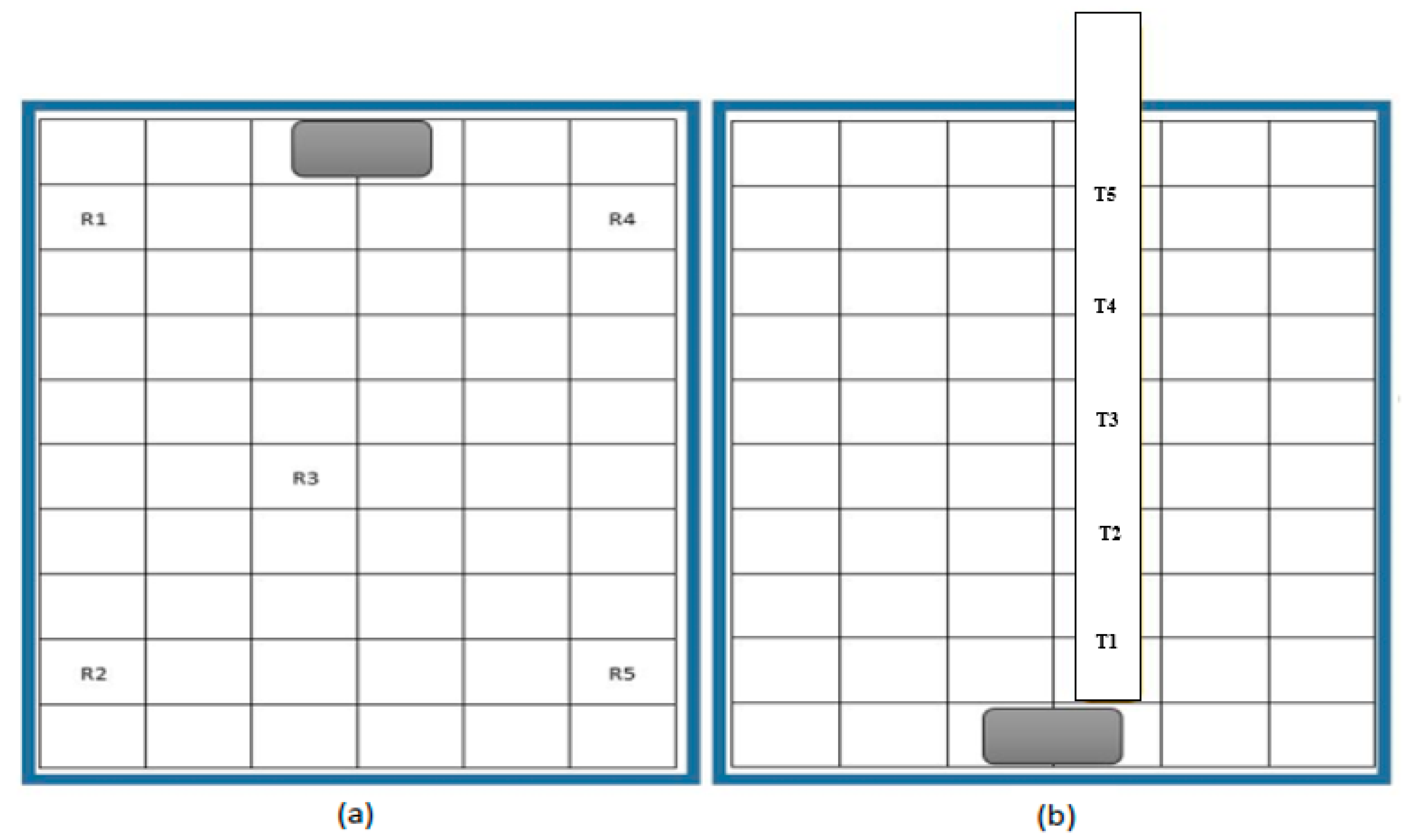
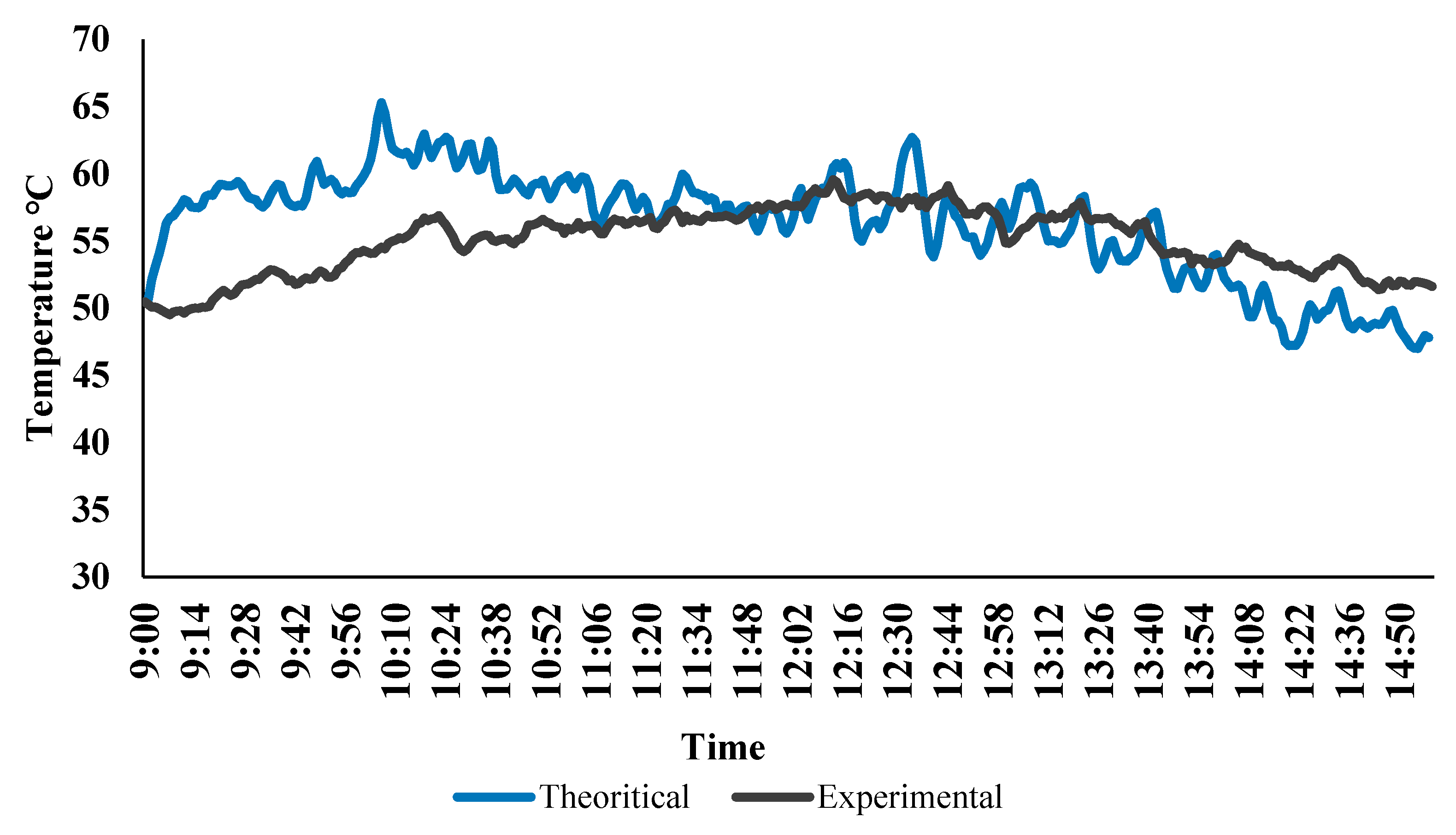
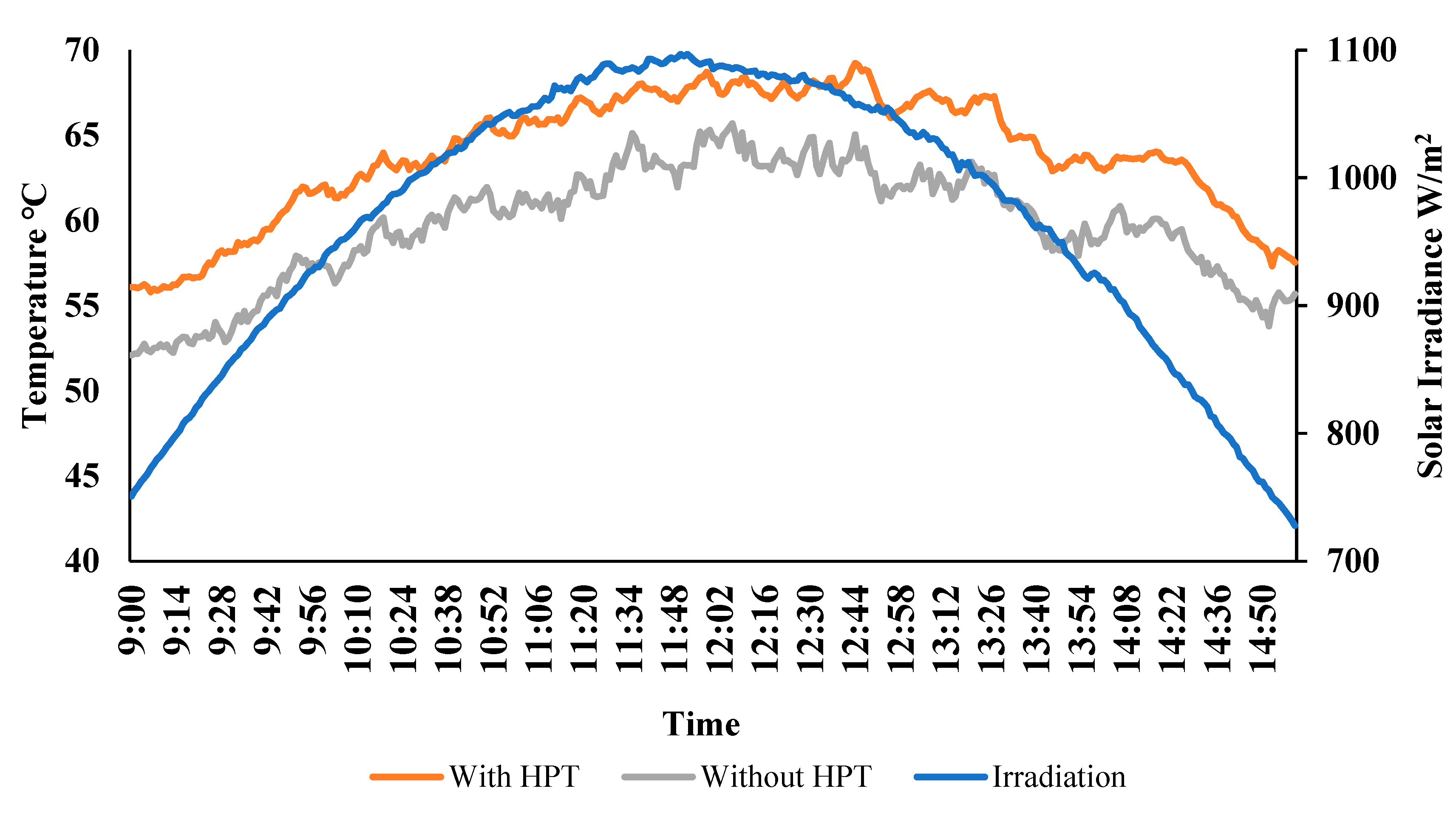
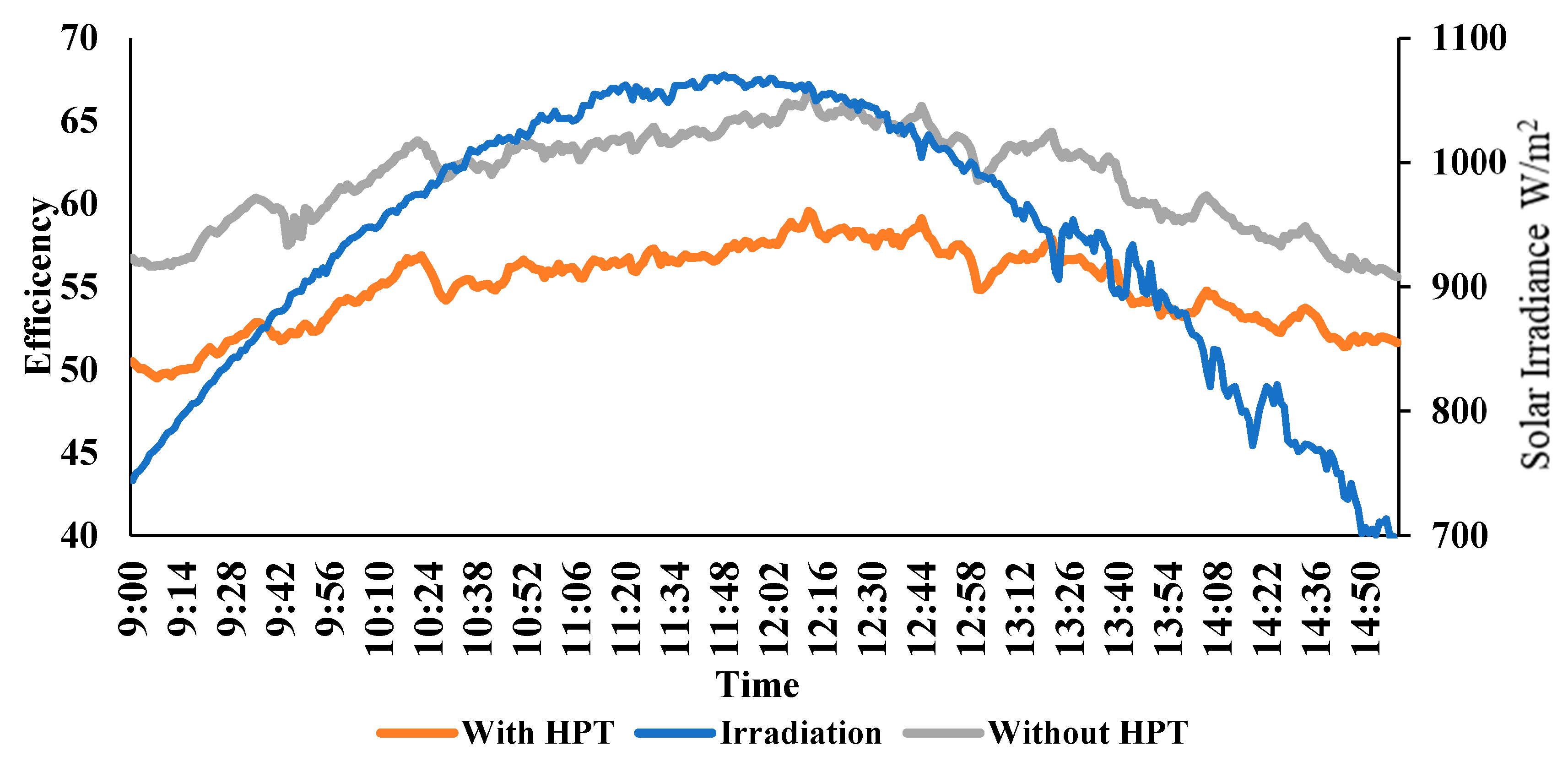
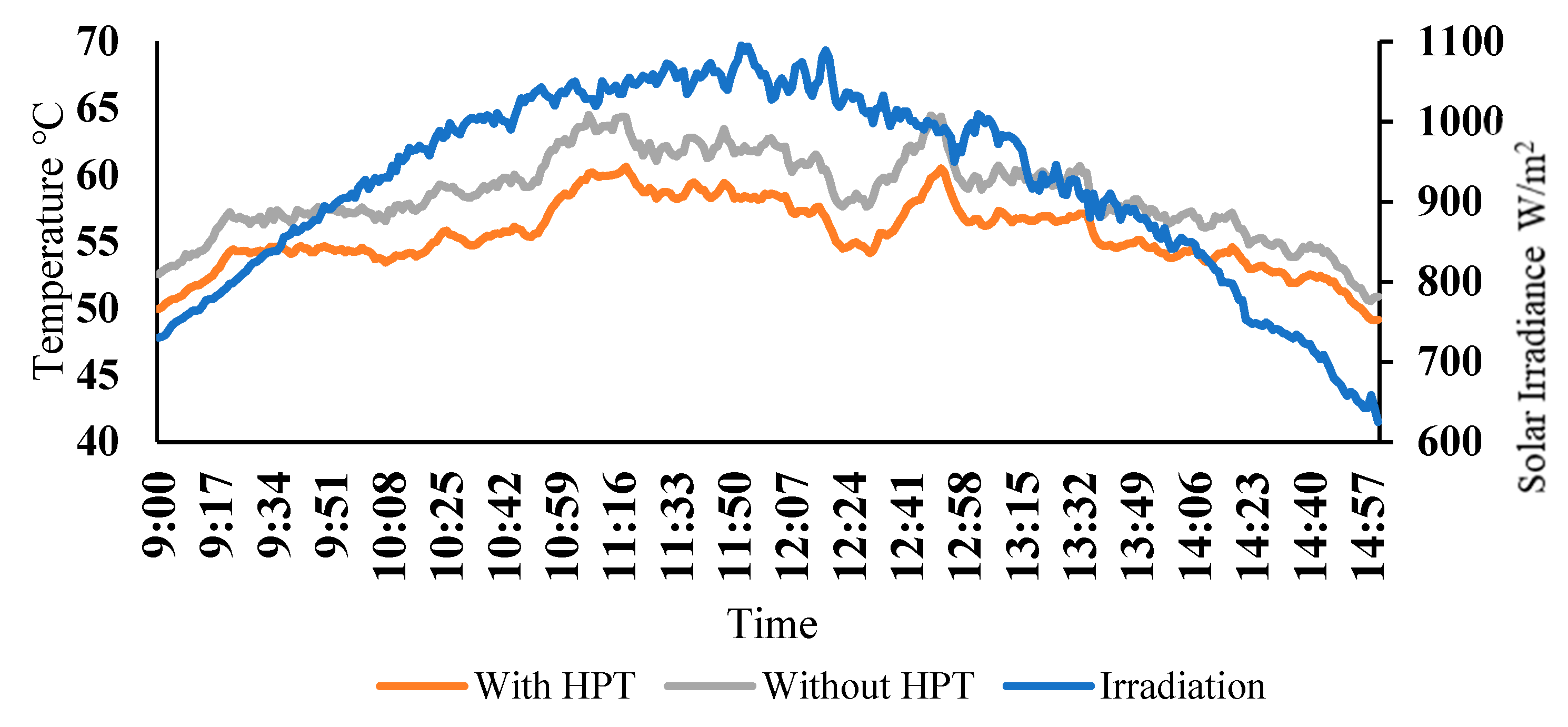

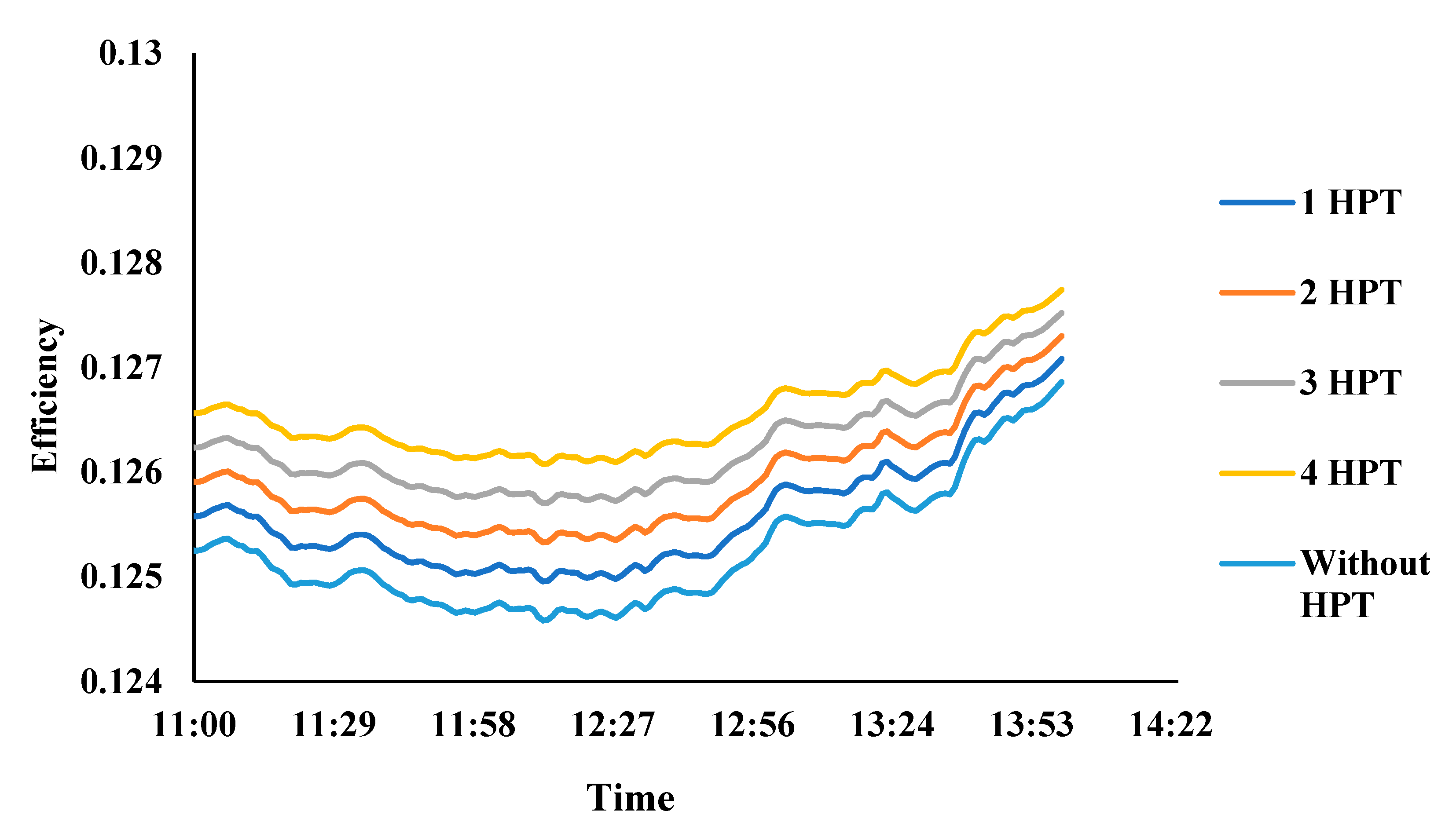

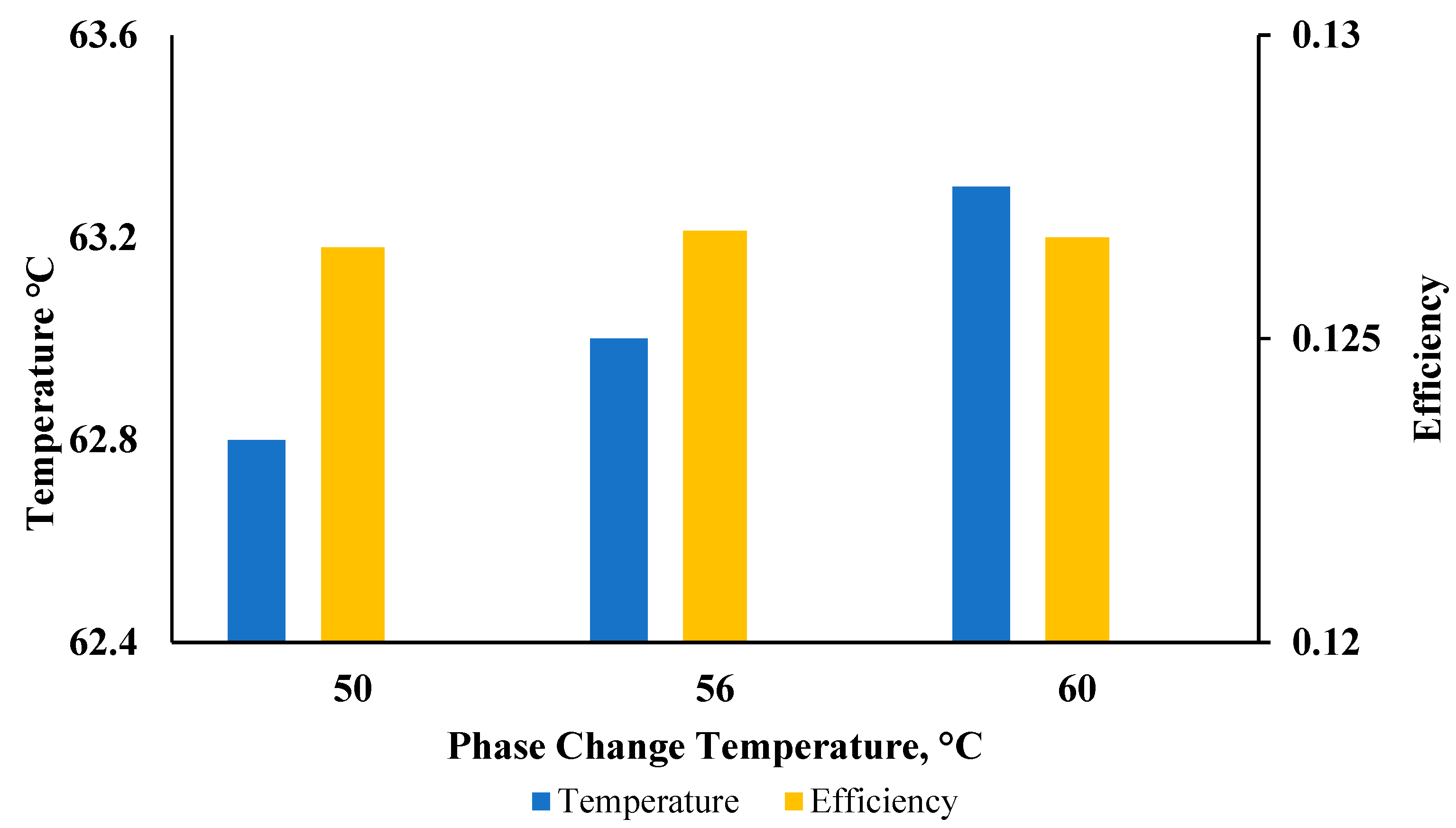
| Layer | Thermal Conductivity (W/mK) | Thickness (m) | Density (kg/m3) | Specific Heat Capacity (J/kg K) |
|---|---|---|---|---|
| Glass | 1.8 | 0.003 | 3000 | 500 |
| ARC | 32 | 100 × 10−9 | 2400 | 691 |
| PV Cells | 148 | 225 × 10−6 | 2330 | 677 |
| EVA top layer | 0.35 | 500 × 10−6 | 960 | 2090 |
| EVA bottom layer | 237 | 10 × 10−6 | 2700 | 900 |
| Tedlar | 0.2 | 0.0001 | 1200 | 1250 |
| Name | Boiling Point | Volume | Density (Liquid) | Density (Vapor at 330 K) |
|---|---|---|---|---|
| Acetone | 56 °C | 0.3925 L/tube | 784 kg/m3 | 2.325 kg/m3 |
Disclaimer/Publisher’s Note: The statements, opinions and data contained in all publications are solely those of the individual author(s) and contributor(s) and not of MDPI and/or the editor(s). MDPI and/or the editor(s) disclaim responsibility for any injury to people or property resulting from any ideas, methods, instructions or products referred to in the content. |
© 2023 by the authors. Licensee MDPI, Basel, Switzerland. This article is an open access article distributed under the terms and conditions of the Creative Commons Attribution (CC BY) license (https://creativecommons.org/licenses/by/4.0/).
Share and Cite
Kaneesamkandi, Z.; Almalki, M.J.; Sayeed, A.; Haidar, Z.A. Passive Cooling of PV Modules Using Heat Pipe Thermosiphon with Acetone: Experimental and Theoretical Study. Appl. Sci. 2023, 13, 1457. https://doi.org/10.3390/app13031457
Kaneesamkandi Z, Almalki MJ, Sayeed A, Haidar ZA. Passive Cooling of PV Modules Using Heat Pipe Thermosiphon with Acetone: Experimental and Theoretical Study. Applied Sciences. 2023; 13(3):1457. https://doi.org/10.3390/app13031457
Chicago/Turabian StyleKaneesamkandi, Zakariya, Mohammed Jarallah Almalki, Abdul Sayeed, and Zeyad A. Haidar. 2023. "Passive Cooling of PV Modules Using Heat Pipe Thermosiphon with Acetone: Experimental and Theoretical Study" Applied Sciences 13, no. 3: 1457. https://doi.org/10.3390/app13031457
APA StyleKaneesamkandi, Z., Almalki, M. J., Sayeed, A., & Haidar, Z. A. (2023). Passive Cooling of PV Modules Using Heat Pipe Thermosiphon with Acetone: Experimental and Theoretical Study. Applied Sciences, 13(3), 1457. https://doi.org/10.3390/app13031457





